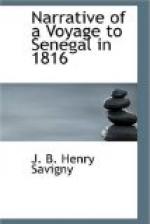On the 17th of June, 1816, at seven in the morning, the expedition for Senegal sailed from the roads of the Island of Aix, under the command of Captain Chaumareys; the vessels composing it were the Medusa[1] frigate of 44 guns, Captain Chaumareys; the Echo[2] corvette, Captain Cornet de Venancourt; the flute La Loire, commanded by Lieutenant Giquel Destouches; and the Argus[3] brig, commanded by Lieutenant Parnajon. The wind was northerly, blowing a fresh breeze; we carried all our sails; but had hardly cleared the port when the wind scanted a little, and we tacked to double the Tower of Chassiron, which is placed at the extremity of the Isle of Oleron.[4] After having plied to windward the whole day, in the evening about five o’clock, the Loire being unable to stem the currents which were at that time contrary, and hindered her from entering the passes, desired leave to cast anchor; M. de Chaumareys granted it, and ordered the whole squadron to anchor. We were then half a league from the Isle of Rhe, within what is called the "Pertuis d’Antioche." We cast anchor the first, and all the other vessels came and placed themselves near us. The Loire being a dull sailer, was the last which came to an anchor. The weather was fine: the wind N.W. and consequently too near to allow us to double Chassiron, with a contrary current. At seven in the evening, at the beginning of the ebb, we weighed anchor, and hoisted our sails; all the other vessels did the same: the signal to get under way had been given them a few minutes before. At night we found ourselves between the lights of Chassiron and La Baleine.[5] A few moments sufficed to double them; we were scarcely clear, when the wind became almost calm; the vessels no longer obeyed the helm, the sky grew dark, the sea was very hollow, in short every thing announced a storm; the wind threatened to blow from the west, and consequently to become contrary; it was variable and squally; towards ten o’clock it was perceived that we were running directly upon a danger, called Les Roches Bonnes.[6] We tacked to escape certain destruction; between eleven and twelve at night, a storm arose in the north, and brought on wind from that quarter; we were then able to advance; the clouds dispersed, and the next day the weather was very fine, with a breeze from the N.E. but very faint; for some days we made but very little progress.
On the 21st or 22d we doubled Cape Finisterre; beyond this point which bounds the Gulph of Gascony, the Loire and the Argus parted company; these vessels sailing very ill, it was impossible for them to keep up with the frigate, which to enable them to do so, would have been obliged to take in her top-gallant sails and studding sails.
The Echo alone was in sight, but at a great distance, and carrying a press of sail not to lose sight of us. The frigate was so much a better sailer than the corvette, that with a small quantity of sail, she not only kept up with her, but even got a-head of her in a surprising manner; the wind had freshened and we were going at the rate of nine knots.[7]




